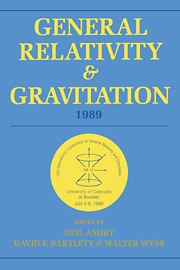 General Relativity and Gravitation, 1989
General Relativity and Gravitation, 1989 Book contents
- Frontmatter
- Contents
- Preface
- Conference committees
- Part A Classical relativity and gravitation theory
- WORKSHOPS
- A1 Exact solutions and exact properties of Einstein equations
- A2 Spinors, twistors, and complex methods
- A3 Alternative gravity theories
- A4 Asymptotia, singularities, and global structure
- A5 Radiative spacetimes and approximation methods
- A6 Algebraic computing
- A7 Numerical relativity
- Part B Relativistic astrophysics, early universe, and classical cosmology
- WORKSHOPS
- Part C Experimental gravitation and gravitational wave detection
- WORKSHOPS
- Part D Quantum gravity, superstrings, quantum cosmology
- WORKSHOPS
- Part E Overviews-past, present, and future
A6 - Algebraic computing
Published online by Cambridge University Press: 05 March 2012
- Frontmatter
- Contents
- Preface
- Conference committees
- Part A Classical relativity and gravitation theory
- WORKSHOPS
- A1 Exact solutions and exact properties of Einstein equations
- A2 Spinors, twistors, and complex methods
- A3 Alternative gravity theories
- A4 Asymptotia, singularities, and global structure
- A5 Radiative spacetimes and approximation methods
- A6 Algebraic computing
- A7 Numerical relativity
- Part B Relativistic astrophysics, early universe, and classical cosmology
- WORKSHOPS
- Part C Experimental gravitation and gravitational wave detection
- WORKSHOPS
- Part D Quantum gravity, superstrings, quantum cosmology
- WORKSHOPS
- Part E Overviews-past, present, and future
Summary
Introductory survey
The implementation of a new computer algebra system is time consuming: designers of general purpose algebra systems usually say it takes about 50 man-years to create a mature and fully functional system. Hence the range of available systems and their capabilities changes little between one GR meeting and the next, despite which there have been significant changes in the period since the last report.
I do not believe there is a single “best” system (though like everybody else I am biased towards the systems I actually use), and in particular one should be extremely cautious about any claims about comparative efficiency of systems. These introductory remarks therefore aim to give a very brief survey of capabilities of the principal available systems and highlight one or two trends. The most recent full survey of computer algebra in relativity (as far as I know) is in Ref. 2, while very full descriptions of the Maple, REDUCE and SHEEP applications will appear in a forthcoming lecture notes volume.
The oldest of the still current general purpose systems are REDUCE and Macsyma. REDUCE is a highly portable system available on a very wide range of machines and is sufficiently cheap to have become widespread in most parts of the world. Its main disadvantage until recently has been the rather small range of auxiliary packages for applied mathematics, but this is improving rapidly with the availability of contributed programs through electronic mail (to reduce-netlib@rand.org: an initial mail should contain the one line ‘send index’).
- Type
- Chapter
- Information
- General Relativity and Gravitation, 1989Proceedings of the 12th International Conference on General Relativity and Gravitation, pp. 113 - 120Publisher: Cambridge University PressPrint publication year: 1990


